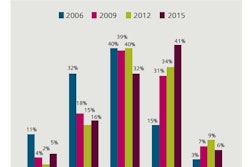This article was written exclusively for ForConstructionPros by small business loan provider Balboa Capital.
Whether you specialize in commercial or residential construction – or perhaps both – it can be highly beneficial to add sustainable construction to your portfolio of capabilities. It can create a market advantage for your business and position it for financial success, particularly as the demand for green construction in both the commercial and residential sectors rise.
The importance of incorporating sustainable materials in the construction of homes, commercial buildings and other structures cannot be overemphasized. The US Green Building Council (USGBC) estimates that buildings in our country account for approximately 30 percent of greenhouse gas emissions, 30 percent of raw material consumption and 12 percent of portable water use. These and many other environmental concerns are leading to an increase in sustainable construction practices. If your construction company is embracing the green building movement, it is part of a niche market that is growing at a rapid pace nationwide.
New and existing homes, schools, commercial buildings, public buildings and hospitals are some of the most common types of structures that are being built or remodeled/retrofitted with environmentally responsible and energy-efficient materials and technologies. So how can sustainable construction benefit your company?
More revenue opportunities
Analysts expect green and sustainable building revenue to grow 23 percent annually over the next three years and reach $290 billion by 2017. According to the USGBC, green construction supports over three million workers in the United States, up from one million just six years ago. The growing demand for green building projects presents your company with an opportunity to generate additional revenue streams if green construction is one of its core capabilities.
Although sustainable homes and buildings might not appear very different from their traditional counterparts, they feature specialized designs and materials that lessen their environmental impact. Creating environmentally friendly homes and buildings requires a collaborative effort between uniquely skilled construction companies, architects, contractors and equipment/materials suppliers. You can establish strategic alliances in the green building industry by personally contacting decision makers, attending trade shows, marketing your green building capabilities online and becoming members of sustainable construction organizations.
Bigger construction budgets
In most cases, creating a sustainable home or building involves higher upfront design and construction costs. Numerous studies and reports have demonstrated that green construction projects cost 1 percent to 10 percent higher than conventional construction projects. Costs will vary based on a number of factors including design, materials, location and schedule. However, it is worth noting that higher up-front construction costs for a sustainable home or building can provide significant financial benefits over the life of the building. Lower electricity and water bills, reduced maintenance fees and less overall upkeep are some of the ways that sustainable construction saves money down the road.
There are also special tax incentives that encourage the construction of sustainable homes and commercial buildings. The amount of tax credits will depend on the structure’s level of sustainability. Whether you are a construction company or contractor, you need to become familiar with the varying construction costs of green construction and with the myriad rules and requirements for obtaining sustainable building tax credits. Becoming well-versed in all facets of green construction can help make the entire process – from initial bidding to project completion – highly efficient for you and your clients. This will also enable you to educate your clients so their expectations are in order.
Remodeling and retrofitting projects
You don’t have to limit your construction company’s green building capabilities to new projects only. In fact, the ideal situation is to also offer remodeling and retrofitting for existing homes and buildings. This gives your company the flexibility and agility to shift gears and pursue additional projects that will help grow your bottom line.
The market for green remodeling and retrofitting is booming. A McGraw Hill Construction report indicates that close to $18 billion will be spent on commercial building retrofit projects by 2015. Homeowners are also going green by remodeling their houses with eco-friendly materials and energy-efficient appliances, windows and lighting. These investments can help lower a homes’ energy cost, reduce its carbon footprint, and increase its value.
Stand out with a green building certification
Many construction companies and construction managers are taking the steps necessary to become certified in sustainable construction. The Green Building Certification Institute (GBCI) and Leadership in Energy and Environmental Design (LEED) accredit businesses and professionals in the green building field. Construction managers can become certified by the National Center for Construction Education and Research (NCCER).
Professional certification in sustainable construction practices can help your construction company stand out in the competitive marketplace. It shows you have met and/or exceeded the stringent green building standards set forth by organizations that are at the forefront of sustainable construction.


















